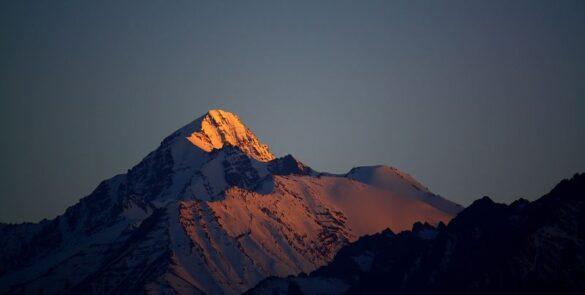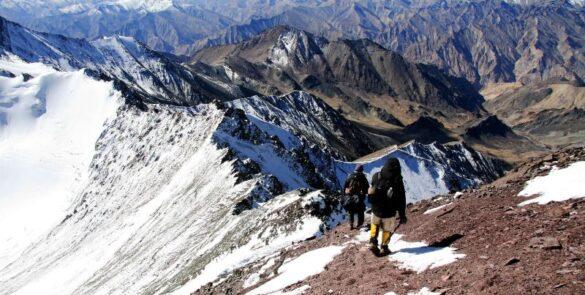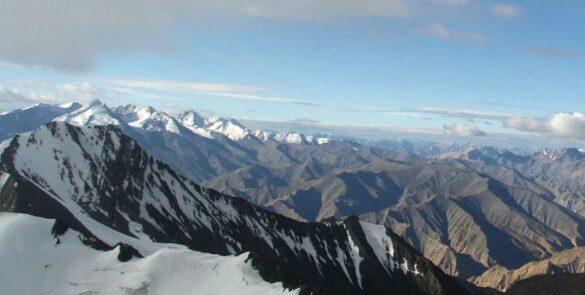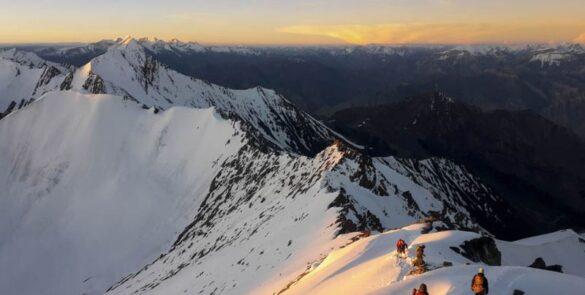Base Camp
Leh
Region
Ladakh
Trek Grade
Difficult
Trek Distance
42 Kms
Trek Duration
9 Days
Highest Altitude
6,153 meters
Best Season
June to September
Pick & Drop Point
Leh
Railway Station
NA
Nearest Airport
Leh
Region
Ladakh
Base Camp
Leh
Trek Grade
Difficult
Trek Distance
42 Kms
Trek Duration
9 Days
Highest Altitude
6,153 meters
Best Season
June to September
Railway Station
NA
Pick & Drop Point
Leh
Nearest Airport
Leh
Contact Us
₹ 25,500
+5% GST
- Transport Included | Leh & Return
ABOUT STOK KANGRI EXPEDITION
Nestled in the majestic landscape of the Ladakh region in northern India, the Stok Kangri Trek stands as a testament to the raw beauty and rugged allure of the Himalayas. This exhilarating adventure offers trekkers a chance to scale one of the highest peaks in the Stok Range, reaching an impressive altitude of 6,153 meters (20,187 feet). From panoramic vistas of snow-capped peaks to the thrill of summiting a challenging peak, the Stok Kangri Expedition promises an unforgettable experience for those seeking adventure in the high mountains.

The Stok Kangri Trek typically begins in the picturesque village of Stok, located approximately 15 kilometers south of Leh, the capital of Ladakh. Trekkers embark on a multi-day journey that takes them through diverse landscapes, including barren valleys, rocky terrain, and glacial passes. The trek route passes through several small villages, providing glimpses into the traditional way of life in the region.
As the trek progresses, the landscape gradually changes, with the towering peaks of the Stok Range dominating the horizon. Trekkers traverse high mountain passes, such as the Kongmaru La Pass, which sits at an elevation of around 5,100 meters (16,730 feet), offering breathtaking views of the surrounding mountains.

The Stok Kangri Expedition is not for the faint of heart. It presents numerous challenges, including high altitude, unpredictable weather conditions, and strenuous terrain. Trekkers must be physically fit and mentally prepared to tackle the demands of the trek.
Proper acclimatization is crucial for success on the Stok Kangri Trek. Leh, situated at an altitude of 3,500 meters (11,500 feet), serves as the starting point for many trekkers and provides an opportunity to acclimatize to the thin air before ascending to higher altitudes. It is recommended to spend at least a couple of days in Leh before beginning the trek to allow the body to adjust to the altitude.

In addition to physical preparation, trekkers must also ensure they have the appropriate gear and equipment for the journey. This includes sturdy hiking boots, warm clothing, a reliable sleeping bag, and a good quality backpack. Trekkers should also carry essential items such as sunscreen, sunglasses, a hat, and plenty of water to stay hydrated.
The highlight of the Stok Kangri Trek is undoubtedly the summit day, where trekkers attempt to reach the peak of Stok Kangri. Depending on the itinerary, summit day typically begins in the early hours of the morning, usually around midnight or shortly thereafter. Trekkers embark on a challenging ascent, navigating steep and rocky terrain illuminated by headlamps.
As trekkers gain altitude, the air becomes thinner, making each step more demanding. Despite the physical and mental challenges, the sense of accomplishment and awe-inspiring views motivate trekkers to persevere. Upon reaching the summit, trekkers are rewarded with panoramic views of the surrounding Himalayan peaks, including K2 and Nanga Parbat in neighbouring Pakistan.
As with any adventure in the wilderness, it is essential to prioritize conservation and responsible trekking practices. The fragile ecosystem of the Himalayas is increasingly vulnerable to the impacts of climate change and human activity. Trekkers should strive to minimize their environmental footprint by practicing leave-no-trace principles, respecting local customs and traditions, and supporting sustainable tourism initiatives.

The Stok Kangri Trek offers intrepid adventurers an opportunity to immerse themselves in the breathtaking beauty and rugged terrain of the Himalayas. From the challenging ascent to the summit to the stunning vistas along the way, this trek is sure to leave a lasting impression on all who undertake it. With proper preparation, a spirit of adventure, and a deep respect for the natural world, the Stok Kangri Trek promises an unforgettable journey into the heart of the mountains.
FIX DEPARTURE
1st, 2nd, 3rd, 4th, 5th, 6th, 7th, 8th, 9th, 10th, 11th, 12th, 13th, 14th, 15th, 16th, 17th, 18th, 19th, 20th, 21st, 22nd, 23rd, 24th, 25th, 26th, 27th, 28th, 29th, 30th June.
1st, 2nd, 3rd, 4th, 5th, 6th, 7th, 8th, 9th, 10th, 11th, 12th, 13th, 14th, 15th, 16th, 17th, 18th, 19th, 20th, 21st, 22nd, 23rd, 24th, 25th, 26th, 27th, 28th, 29th, 30th, 31st July.
1st, 2nd, 3rd, 4th, 5th, 6th, 7th, 8th, 9th, 10th, 11th, 12th, 13th, 14th, 15th, 16th, 17th, 18th, 19th, 20th, 21st, 22nd, 23rd, 24th, 25th, 26th, 27th, 28th, 29th, 30th, 31st Aug.
1st, 2nd, 3rd, 4th, 5th, 6th, 7th, 8th, 9th, 10th, 11th, 12th, 13th, 14th, 15th, 16th, 17th, 18th, 19th, 20th, 21st, 22nd, 23rd, 24th, 25th, 26th, 27th, 28th, 29th, 30th Sep.
FAQs
Stok Kangri stands at an impressive altitude of 6,153 meters (20,187 feet) above sea level, making it one of the highest peaks in the Ladakh region of India.
The Stok Kangri Trek is considered a challenging trek that requires a good level of physical fitness and prior trekking experience at high altitudes. Beginners are advised to undertake trekking experience and adequate preparation and consider shorter treks in the region before attempting Stok Kangri.
The ideal trekking season for Stok Kangri is generally from June to September when the weather is relatively stable, and the mountain passes are free from snow. However, trekkers should be prepared for cold temperatures and rapid weather changes, even during the summer months.
Yes, trekkers need to obtain permits from the local authorities, usually in Leh, before embarking on the Stok Kangri Trek. These permits are necessary to enter certain restricted areas and help ensure the safety and preservation of the environment.
The duration of the trek can vary depending on the chosen route and itinerary. Generally, the trek takes around 8 to 9 days to complete, including acclimatization days in Leh and the trekking days to and from the base camp and summit.
Essential items to pack include sturdy hiking boots, warm clothing, poncho, a backpack, sunscreen, sunglasses, a hat, and water bottle. Trekkers should also carry basic medical supplies and snacks for energy.
Yes, altitude sickness is a potential risk when trekking to high altitudes such as Stok Kangri. It is essential to acclimatize properly by spending a few days in Leh before ascending to higher elevations and to stay hydrated throughout the trek.
While there are no dedicated rescue facilities on the trek route, there are emergency services available in Leh. Trekkers should have travel insurance that covers high-altitude trekking and emergency evacuation in case of accidents or medical emergencies.
Accommodation options along the trek route are limited, primarily consisting of tents at designated campsites. Trekkers should be prepared to camp in remote wilderness areas and carry their own trekking equipment or arrange for it through a trekking agency.
Stok Kangri, a popular trekking destination in Ladakh, is currently closed due to environmental concerns. The temporary closure of Stok Kangri is also attributed to issues related to glacial water, which serves as a vital source of water for Stok Village. The disruption caused by excessive trekking activities threatens the availability and purity of this crucial water source.The closure is a proactive measure taken by local authorities to preserve the fragile ecosystem of the region. In addition, environmental problems such as excessive human traffic, waste accumulation, and ecosystem degradation have been observed in the Stok Kangri area. These issues threaten the biodiversity and natural balance of the region, prompting the temporary closure of the trekking route.
DETAILED ITINERARY
Altitude : 11,500 ft
Check into your Hotel
Local market visit in the evening
Arrive at Kushok Bakula Rimpochee Airport in Leh, Ladakh. Meet your trekking guide and transfer to your pre-booked hotel in Leh. Rest and relax to acclimatize to the high altitude of 11,500 feet. Drink plenty of water and avoid strenuous activities. If time permits, take a short walk around Leh town to get acquainted with the surroundings. Attend a briefing session by your trek leader in the evening, discussing the itinerary and safety precautions for the trek ahead.
Rest and Acclimatization day
Explore Leh
Spend the day in Leh for further acclimatization. Enjoy a leisurely breakfast at the hotel. Visit Leh Palace, a former royal palace overlooking the town, and explore its historical and cultural significance. Take a stroll through the bustling markets of Leh, where you can shop for souvenirs and local handicrafts. Visit Shanti Stupa, a Buddhist white-domed stupa offering panoramic views of the surrounding mountains and valleys. Enjoy a hearty dinner back at the hotel and rest early to prepare for the trek.
Drive : 15 kms, 40 mins
Trek : 6 km, 5-6 hours
Altitude : 13,087 ft
Overnight stay in tents
After an early breakfast, drive to Stok Village, approximately 15 kilometers from Leh (about 40 minutes). Begin the trek from Stok Village towards Chang Ma, situated at an altitude of 13,087 feet. The trail passes through picturesque landscapes, with views of Stok Kangri and surrounding peaks. Stop for lunch en route at a suitable spot. Arrive at Chang Ma campsite by late afternoon. Set up tents and relax for the evening, enjoying a warm meal prepared by the support staff. Attend a short briefing by the trek leader regarding the next day's trekking route and safety measures.
- Trek:4km,4hour
- Max Altitude : 14,200 ft
After breakfast, start trekking from Chang Ma to Mankorma, located at an altitude of 14,200 feet. The trail gradually ascends through barren landscapes with occasional sightings of wildlife such as marmots and blue sheep. Enjoy packed lunch at a scenic spot along the way. Reach Mankorma campsite by late afternoon. Settle into the campsite, relax, and enjoy the serene surroundings. Dinner will be served at the campsite, followed by a briefing session by the trek leader.
Trek : 4 km, 4-5 hours
Altitude : 16,300 ft
Today's trek takes you from Mankorma to the Base Camp, situated at an altitude of 16,300 feet. The trail involves a gradual ascent, offering stunning views of the surrounding mountains and glaciers. Enjoy packed lunch at a suitable spot along the way. Arrive at the Base Camp by afternoon. Set up tents and settle in for the evening. Attend a thorough briefing session by the trek leader, discussing the summit push and safety protocols for the next day.
Rest and Acclimatization Day
Training day to climb summit
Summit push briefing
Spend the day at the Base Camp for further acclimatization and preparation. Engage in light exercises and short hikes to higher elevations to aid acclimatization. Receive instructions from the trek leader on using climbing equipment and practicing basic climbing techniques. Rest and hydrate adequately to prepare for the summit attempt the following day. Attend a final briefing session in the evening, discussing the summit strategy and safety measures.
Trek : 7 km each, 11-12 hours
Altitude : 20,187 ft / 6,153 m
Start the summit push in the early hours of the morning, typically around midnight, to take advantage of stable weather conditions. Trek towards the summit of Stok Kangri, the highest peak in the Stok Range, standing at 20,187 feet. Navigate through rocky terrain and snowfields under the guidance of experienced trek leaders. Reach the summit and celebrate the achievement with panoramic views of the Himalayas. Spend some time at the summit, soaking in the breathtaking vistas and capturing memorable photographs. Begin the descent back to the Base Camp, carefully navigating the terrain. Arrive back at the Base Camp by evening. Enjoy a well-deserved rest and a hearty meal to celebrate the successful summit.
Trek : 14 km, 7-8 hours
Overnight stay in Hotel at Leh
After breakfast, dismantle the camp and prepare for the return journey. Trek back to Stok Village, retracing your steps through the scenic landscapes. Bid farewell to the mountains and drive back to Leh. Check into your hotel upon arrival in Leh. Spend the rest of the day at leisure, relaxing and reflecting on the memorable trekking experience. Enjoy a farewell dinner with your fellow trekkers and share stories and experiences from the expedition.
After breakfast, transfer to Kushok Bakula Rimpochee Leh Airport for your onward journey. Bid farewell to Leh and its stunning landscapes, carrying cherished memories of the Stok Kangri trek.
End of services.
FIX DEPARTURE
1st, 2nd, 3rd, 4th, 5th, 6th, 7th, 8th, 9th, 10th, 11th, 12th, 13th, 14th, 15th, 16th, 17th, 18th, 19th, 20th, 21st, 22nd, 23rd, 24th, 25th, 26th, 27th, 28th, 29th, 30th June.
1st, 2nd, 3rd, 4th, 5th, 6th, 7th, 8th, 9th, 10th, 11th, 12th, 13th, 14th, 15th, 16th, 17th, 18th, 19th, 20th, 21st, 22nd, 23rd, 24th, 25th, 26th, 27th, 28th, 29th, 30th, 31st July.
1st, 2nd, 3rd, 4th, 5th, 6th, 7th, 8th, 9th, 10th, 11th, 12th, 13th, 14th, 15th, 16th, 17th, 18th, 19th, 20th, 21st, 22nd, 23rd, 24th, 25th, 26th, 27th, 28th, 29th, 30th, 31st Aug.
1st, 2nd, 3rd, 4th, 5th, 6th, 7th, 8th, 9th, 10th, 11th, 12th, 13th, 14th, 15th, 16th, 17th, 18th, 19th, 20th, 21st, 22nd, 23rd, 24th, 25th, 26th, 27th, 28th, 29th, 30th Sep.
THINGS TO CARRY
BASIC GEARS
- Backpack & Rain Cover (50-70 Litres)
- Hiking bag (20 litre)
- Trekking Shoes (Ankle Shoes)
- Warm clothes
- Water Bottles
CLOTHES
- Jacket (Down or padded)
- Fleece or woolen clothes
- Trek pants and Trousers
- T-shirts (collar and full sleeves)
- Thermal inner wears (both upper and lower)
- Woolen or Fleece cap
- Hand Gloves
- Socks (4 pairs)
- Neck cover, Muffler, Balaclava, any
ACCESSORIES
- Sunglasses
- Sunscreeen Lotion (SPF 50/70)
- Moisturizer and Lip Balm
- Sun cap
- Raincoat and Ponchos
- Power banks
- Trekking pole
- Headlight
OTHERS
- Small Hiking bag (10-20litre) (for summit climb or if you opt to offload your backpack)
- Tiffin box
- Flip flops
- Glucose, Dry fruits
- Personal Toiletries kit
- Toilet paper roll and sanitizer
- Personal basic medical kit
MANDATORY DOCUMENTS
- Original with photocopy of government photo identity card any one (Passport, Aadhaar Card, Driving license or Voter ID)
INCLUSIONS
- Transportation : Leh & Return
- Accommodation (Hotel, Homestay, Camping)
- Meals : All Meals as per menu from first day Dinner to last day Breakfast at basecamp; Vegetarian Meal.
- Camping charges : Camping and forest permit fees for Indian Nationals.
- Trekking equipment : High quality tents (living tent- triple sharing, kitchen tent, dinning tent, toilet tent)
EXCLUSIONS
- Meals during road journeys
- Insurance
- Any personal expenses
- Mules or porter to carry personal luggage
- Anything apart from inclusions
Backpack Offloading Charges
• Offload your backpack to a mule or porter to lighten your load during the trek.
• Offloading charges range from ₹300 to ₹900 per day per bag, depending on the specific trek.
• Ensure your backpack weighs less than 11 kg and is equipped with a waterproof cover.
• Suitcases, trolleys, or duffel bags are not allowed.
POLICY
Booking Confirmation Policy
• The customer receives a Booking confirmation receipt immediately via Email and WhatsApp of a successful booking.
Cancellation policy
In the event you cancel your trek, cancellation policy we follow :
• Cancellation 20 days before the starting date of the trek – Refund with 10% cancellation charges.
• Cancellation 10 days before the starting date of the trek – Refund with 50% cancellation charges
• Cancellation less than 10 days from the starting date of the trek – No refund
Note: HA gives you a facility in the event of cancellation due to some reason to transfer your trek (same trek and same batch) to your friend.
REFUND :
• The refund will be given in the form of a trek voucher with 1 year validity, you will get an email for your trek voucher, which will take up to 7 working days.
FAQs
Stok Kangri stands at an impressive altitude of 6,153 meters (20,187 feet) above sea level, making it one of the highest peaks in the Ladakh region of India.
The Stok Kangri Trek is considered a challenging trek that requires a good level of physical fitness and prior trekking experience at high altitudes. Beginners are advised to undertake trekking experience and adequate preparation and consider shorter treks in the region before attempting Stok Kangri.
The ideal trekking season for Stok Kangri is generally from June to September when the weather is relatively stable, and the mountain passes are free from snow. However, trekkers should be prepared for cold temperatures and rapid weather changes, even during the summer months.
Yes, trekkers need to obtain permits from the local authorities, usually in Leh, before embarking on the Stok Kangri Trek. These permits are necessary to enter certain restricted areas and help ensure the safety and preservation of the environment.
The duration of the trek can vary depending on the chosen route and itinerary. Generally, the trek takes around 8 to 9 days to complete, including acclimatization days in Leh and the trekking days to and from the base camp and summit.
Essential items to pack include sturdy hiking boots, warm clothing, poncho, a backpack, sunscreen, sunglasses, a hat, and water bottle. Trekkers should also carry basic medical supplies and snacks for energy.
Yes, altitude sickness is a potential risk when trekking to high altitudes such as Stok Kangri. It is essential to acclimatize properly by spending a few days in Leh before ascending to higher elevations and to stay hydrated throughout the trek.
While there are no dedicated rescue facilities on the trek route, there are emergency services available in Leh. Trekkers should have travel insurance that covers high-altitude trekking and emergency evacuation in case of accidents or medical emergencies.
Accommodation options along the trek route are limited, primarily consisting of tents at designated campsites. Trekkers should be prepared to camp in remote wilderness areas and carry their own trekking equipment or arrange for it through a trekking agency.
Stok Kangri, a popular trekking destination in Ladakh, is currently closed due to environmental concerns. The temporary closure of Stok Kangri is also attributed to issues related to glacial water, which serves as a vital source of water for Stok Village. The disruption caused by excessive trekking activities threatens the availability and purity of this crucial water source.The closure is a proactive measure taken by local authorities to preserve the fragile ecosystem of the region. In addition, environmental problems such as excessive human traffic, waste accumulation, and ecosystem degradation have been observed in the Stok Kangri area. These issues threaten the biodiversity and natural balance of the region, prompting the temporary closure of the trekking route.





